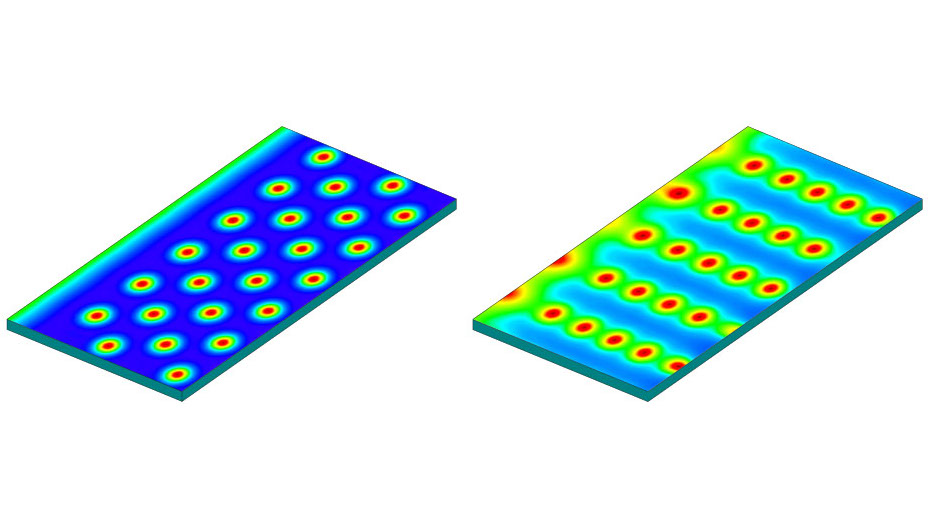Superconductivity is a physical phenomenon occurring at low temperatures in many materials which manifests itself through a vanishing electrical resistance and the expulsion of magnetic fields from the material’s interior. Superconductors are already used for medical imaging, fast digital circuits or sensitive magnetometers and hold a great potential for further applications. However, the conductivity of the majority of technologically important superconductors is in fact not “super”. In these so-called type II superconductors an external magnetic field penetrates the material in the form of quantized lines of magnetic flux. These flux lines are known as Abrikosov vortices, named after Alexei Abrikosov whose prediction brought him the Nobel prize in Physics in 2003. Already at moderately strong electric currents, the vortices begin to move and the superconductor can no longer carry the current without resistance.
In most superconductors, a low-resistive state is limited by vortex velocities of the order of 1 km/s setting the practical limits of use of superconductors in various applications. At the same time, such velocities are not high enough to address the rich physics generic to nonequilibrium collective systems. Now, an international team of scientists from the University of Vienna, the Goethe University Frankfurt, the Institute for Microstructures of RAS, the V. Karazin National University of Kharkiv, the B. Verkin Institute for Low Temperature Physics and Engineering of NAS has found a new superconducting system in which magnetic flux quanta can move at velocities of 10-15 km/s. The new superconductor exhibits a rare combination of properties – high structural uniformity, large critical current and fast relaxation of heated electrons. The combination of these properties ensures that the phenomenon of flux-flow instability – abrupt transition of a superconductor from the low-resistive to the normal conducting state – takes place at sufficiently large transport currents.
“In recent years, there have appeared experimental and theoretical works pointing to a remarkable issue; it has been argued that current-driven vortices can move even faster than the superconducting charge carriers.”, says Oleksandr Dobrovolskiy, lead author of the recent publication in Nature Communications and head of the Superconductivity and Spintronics Laboratory at the University of Vienna. “However, these studies used locally non-uniform structures. Initially, we worked with high-quality clean films, but later it turned out that dirty superconductors are better candidate materials to support ultra-fast vortex dynamics. Though the intrinsic pinning in these is not necessarily as weak as in other amorphous superconductors, the fast relaxation of heated electrons becomes the dominating factor allowing for ultrafast vortex motion”.
For their investigations the researchers fabricated a Nb-C superconductor by focused ion beam induced deposition in the group of Prof. Michael Huth at the Goethe University in Frankfurt am Main, Germany. Remarkably, in addition to ultra-fast vortex velocities in Nb-C, the direct-write nanofabrication technology allows one to fabricate complex-shaped nano-architectures and 3D fluxonic circuits with intricate interconnectivity which may find application in quantum information processing.
Challenges for investigations of ultra-fast vortex matter
“In order to reach the maximum current that a superconductor can carry, the so-called depairing current, one needs rather uniform samples over a macroscopic length scale which is partially owed to small defects in a material. Reaching the depairing current is not only a fundamental problem, but it is also important for applications; a micrometer-wide superconducting strip can be switched to a resistive state by a single near infrared or optical photon if the strip is biased by a current close to the depairing current value, as was predicted and confirmed in recent experiments. This approach opens perspectives for building large-area single photon detectors which could be used in e.g. confocal microscopy, free-space quantum cryptography, deep space optical communication,” says Denis Vodolazov, Senior Researcher at the Institute for Microstructures of RAS, Russia.
The researchers successfully studied how fast vortices can move in dirty Nb-C superconducting strips having a critical current at zero magnetic field close to the depairing current. Their results indicate that the flux flow instability starts near the edge where vortices enter the sample because of the locally enhanced current density. This offers insights into the applicability of widely used flux flow instability models and suggest Nb-C to be a good candidate material for fast single-photon detectors.
Publication in Nature Communications:
O. V. Dobrovolskiy, D. Yu. Vodolazov, F. Porrati, R. Sachser, V. M. Bevz, M. Yu. Mikhailov, A. V. Chumak, and M. Huth. Ultra-fast vortex motion in a direct-write Nb-C superconductor, Nature Communications
DOI: 10.1038/s41467-020-16987-y, (2020).
Original post https://alertarticles.info


